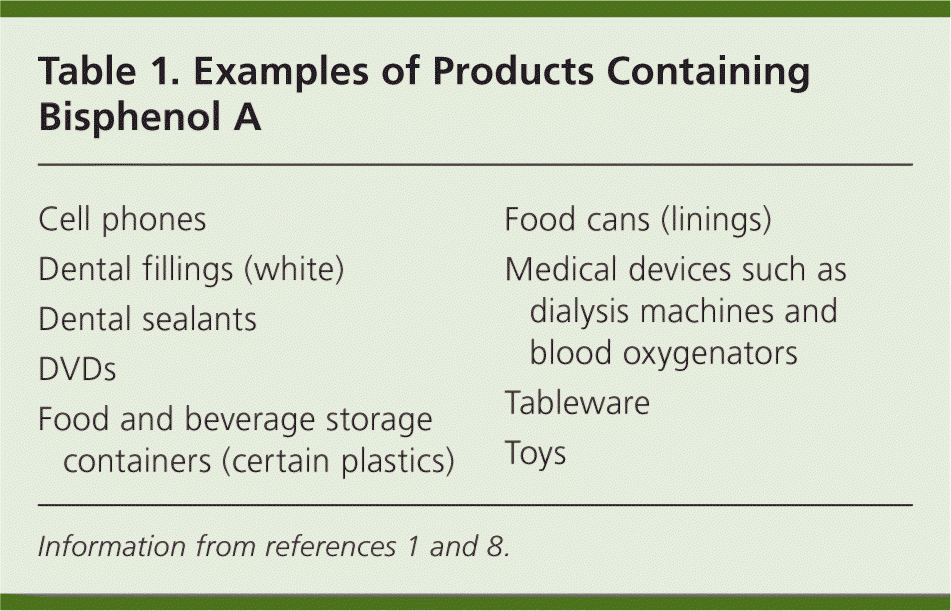
Am Fam Physician. 2012;85(11):1040-1044
Author disclosure: No relevant financial affiliations to disclose.
Bisphenol A (BPA) is a polymerization agent used in the manufacturing of polycarbonate plastics and epoxy resins. It is also an environmental endocrine disruptor with estrogen-like activity that may affect the development and health of those who are exposed. Even when circulating in very low concentrations, estrogen elicits cellular responses, many of which are important for normal fetal development, health, and reproduction. BPA can act like estrogen, binding to the same cellular receptors and altering the hormonal balance of the body. For this reason, some experts are concerned that exposure to BPA could lead to detrimental health effects.
BPA is detectable in more than 92 percent of Americans, with the young carrying the highest burden.1–3 Although BPA is metabolized and excreted by persons with mature liver function, indicating that exposure is pervasive and consistent, fetuses and newborns do not excrete it as efficiently.4 Prenatal exposure occurs from maternal contact, with BPA detected in placental tissue, cord blood, and fetal blood.2,5
The primary route of infant, child, and adult exposure is ingestion of BPA that has leached from BPA-containing products.6,7 Table 1 includes examples of products that commonly contain BPA.1,8 Concerns regarding BPA arose soon after the realization that it can leach out of containers (e.g., food cans, water bottles) and into the food and beverages they hold.9,10

| Cell phones |
| Dental fillings (white) |
| Dental sealants |
| DVDs |
| Food and beverage storage containers (certain plastics) |
| Food cans (linings) |
| Medical devices such as dialysis machines and blood oxygenators |
| Tableware |
| Toys |
Most studies of BPA exposure, numbering in the hundreds, focus on animal models and indicate diverse potential detrimental health effects. Nonetheless, there has been controversy over the past 15 to 20 years regarding the safety of BPA in humans. During fetal development, cells and tissues are especially susceptible to alterations in the hormonal environment. Therefore, many animal studies center on the effect of BPA exposure during this time frame.11 Largely on the basis of such studies, scientific review panels have indicated that some detrimental health effects may occur in humans (Table 2).4,11,12

| Early onset of puberty in females11,12 |
| Reduction or loss of sexual dimorphism in brain structure4,11 |
| Reduction of sexually dimorphic behaviors leading to demasculinization4,11 |
| Mammary gland effects (lesions, early fat pad maturation, enhanced duct growth)11 |
| Epigenetic programming† during organogenesis persisting into adulthood (affects the prostate, the mammary glands, brain structure, and behavior)4 |
| Prostate changes (increased organ weight, lesions, altered development)4,12 |
| Reduction in sperm4 |
| Disruption of estrous cycling4 |
In response to the potential risks of BPA exposure, the U.S. Environmental Protection Agency added BPA to its “chemicals of concern” list in 2010.13 Moreover, the U.S. Department of Health and Human Services Web site contains an Information for Parents section (http://www.hhs.gov/safety/bpa) on how to minimize BPA exposure in newborns and infants.
Those concerned about the potential risks of BPA can take steps to reduce their exposure level. Pregnant women can reduce fetal exposure by limiting their own exposure to the chemical.7 Reducing the use of polycarbonate plastics as food and beverage containers, and opting for fresh and frozen food rather than canned goods are also positive options for reducing exposure.14 Polycarbonate plastics are usually clear, hard, and shatter-resistant, and they may be labeled with recycle number 7 (although not all number 7 plastics contain BPA). Proper care and use of these containers will help as well. Heating and physical wear increase the rate at which BPA will leach from a container. Accordingly, plastics should not be used if scratched and should not be microwaved or washed in the dishwasher, even if they are labeled as dishwasher safe.10 Damaged or older food cans do not appear to greatly increase the amount of BPA that is leached into the food.9,14
Some premade liquid infant formulas are packaged in BPA-containing bottles and have been shown to be contaminated, whereas the packaging of powdered formula is free of BPA.15 In addition, infant exposure to BPA through breast milk can be reduced if the woman reduces her own BPA intake.
Child behavior can lead to unanticipated exposure to BPA because children are likely to mouth plastic products, such as the hard plastic portion of a pacifier. Parents should be mindful of products for children that may contain BPA, such as toys and sippy cups.1,14 Manufacturers are increasingly labeling products as BPA-free to make others aware of BPA exposure. As of 2011, legislation had been passed in 10 states limiting the use of BPA in products for children. Studies show that after Japanese industries significantly reduced BPA use between 1998 and 2003, there was a dramatic decline in body levels of BPA throughout the entire population.16 In June 2011, the American Medical Association formally recognized BPA as an endocrine-disrupting agent. The American Medical Association also supports continued industry efforts to produce BPA-free infant products, as well as a total ban on the sale of such products and better labeling of BPA-containing products.17 On March 30, 2012, the U.S. Food and Drug Administration, in response to a petition submitted by the Natural Resources Defense Council, maintained that current data is not persuasive enough to warrant banning BPA in human food and packaging.18
Although the risk of BPA exposure in animals has been decisively established, the status of its safety in humans remains uncertain. However, physicians can educate patients about the potential risks and the precautionary measures they can take to reduce their exposure.8
